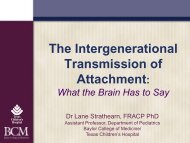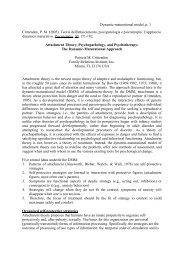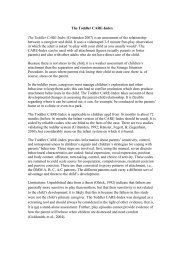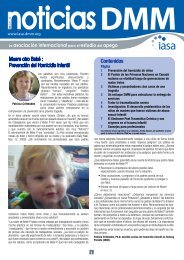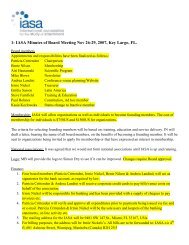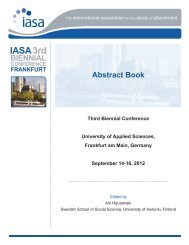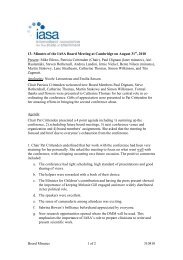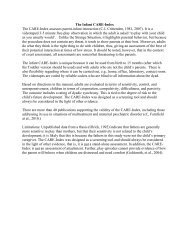Layout 1 (Page 1) - IASA
Layout 1 (Page 1) - IASA
Layout 1 (Page 1) - IASA
You also want an ePaper? Increase the reach of your titles
YUMPU automatically turns print PDFs into web optimized ePapers that Google loves.
NEWSLETTER OF THE INTERNATIONAL ASSOCIATION FOR THE STUDY OF ATTACHMENT OCT 07Contents• Introduction to <strong>IASA</strong> and the DMM newsletter• ‘Pat’s column’• News and pics from Newcastle-first meeting of the <strong>IASA</strong>• Literature reviews• Call for presentations and papers for 2008• UK Government interest in DMM assessment in Forensics• DMM user surveyIntroductionThe task of ‘<strong>IASA</strong>’ was seen as the focus for the work from the DynamicMaturational Model (DMM) to bring together not just the existingliterature, but the now significant potential of the manpower involved indeveloping practise and research. These people include a wide variety ofexperienced, mental health clinicians, social workers and researchers,with strong contingents in North and South America, Europe and Australia.Many of these have attended courses and even become trainers inapplying DMM methods, developed by Patricia Crittenden.Over the next year, we are looking to stimulate bringing together existingand new developments in research, guidelines in the use of (DMM) tools inforensic work, including infant welfare; and facilitate a marriage of theseideas with mainstream social and mental health knowledge and practise.How are we going to carry this forward?A committee was formed in Newcastle (UK) in April 2007, which hopes toannounce a structure and constitution that will serve its interest group andprofessional needs with a clear vision of its ethical and researchresponsibilities - internationally. More news on this in our secondnewsletter at the end of October.The newsletter will link (hopefully everyone) who has participated incourses, to those engaged as trainers or in research.We aim to ‘cascade’ the newsletter via international representatives, andambitiously will try to translate it to all the participating languages.To date we have translators for Italian, Spanish and Swedish. If you wishto volunteer to be an international rep or to translate, please contactthe newsletter Editor at dmmnewsletter@talktalk.net or feedbackon this issue. At present the newsletter is free and operates along withPatricia Crittenden’s website http://www.patcrittenden.com, but in thefuture will likely be part of one website and require a subscription.The goal is to bring all this together in an exciting conference in Bologna,Italy from 10 -12th October 2008.Franco Baldoni and Andrea Landini are organising the conference. Thispromises to be an excellent event supported by the University of Bologna,which also means it will be reasonably priced. The location is ‘bella’!Please bring guitars, flutes, Northumberland pipes, singing voices etc - sothere will be lots of opportunities for pleasant images.Mike Blows Editor1Greetings toeveryone,to all the‘DMMers’!These are excitingtimes! The meeting inNewcastle, organizedby P.O., set lots ofthings in motion. Thanksto your hard work, we leftwith a plan. Over the summer afew of us brought that plan to life.Since those two days, we have gained a name:The International Association for the Study of Attachment. <strong>IASA</strong>.That’s us!We have a Board:Mike Blows from the UK, newsletter editorPatricia Crittenden from the USA, chairpersonKasia Kozlowska from AustraliaAndrea Landini from Italy, conference organizerIrmie Nickel from Canada, treasurerBente Nilsen from Norway, secretary & newsletter associate editor.We have incorporated as a non-profit organization. We have a budget(Thank you, Irmie). We have a tentative mission statement (Thank you,Andrea & Simon Wilkinson). We have an <strong>IASA</strong> webpage underdevelopment (Thank you, Andrea). We have a first small conference comingup for DMM applications to forensic work with violent criminals (Thank you,Clark Baim). Look at Clark’s column in this newsletter. We hope there willbe other such conferences on other topics and in other countries. Theplanning for our first International Congress in Bologna, Italy, Oct. 10-12,2008 is moving ahead (Thank you, Airi Hautamäki, Franco Baldoni &Andrea). We have a newsletter, the DMM News (Thank you, Mike & Bente),and thanks to Paul Holmes who is working on a constitution.We’re on our way!!!The meeting in Newcastle also marks a moment on the cusp of time,between the accomplishments of the past and the opportunities ofthe future.If I think first of what is accomplished, Bowlby’s 1954 paper announcedthe need for a new theory, one based on protecting children from thedangers of separation and loss. Bowlby imagined that attachment theorycould reduce suffering by both prevention and improved treatment. Hisideas gained little attention and less acceptance until Mary Ainsworthprovided empirical data on individual differences in infants’ patterns ofattachment. Even though data has made attachment theory respectable,and ‘attachment’ is often mentioned, treatment has barely changed.(continued on following page)
Now, after a half century of effort, we have a developmental extensionof attachment theory across the lifespan and an expansion of it acrossthe range of adaptation and maladaptation. With these, we faceAinsworth’s challenge:Can we provide sound, replicable data to (1) validate our theory andassessments and (2) shape a more effective, evidence-based approachto treatment?I can’t tell you how special it was to see so many of you in Newcastle. Almost50 professionals from 20 countries and 4 continents, representing at least6 disciplines and all the major theories of treatment were represented. Withthe energy and skills of a group like ours, we have the possibility of fulfillingthe dream of transforming the way treatment is conceptualized anddelivered. Specifically, our new organization faces the challenges of:1 Providing sound research that addresses theory, assessment, andapplication,2 Using empirical findings to continue to develop theory and assessment,3 Applying these to a theory of treatment that can guide social policyand service implementation.The Dynamic-Maturation Model of Attachment (DMM) offers a way to jointheory of adaptation, empirical data, and theory of treatment.I want to thank each of you for your contribution to this effort to helpchildren and families. Whether you contributed cases that informedtheory, or data to test ideas, or experience with treatment, without eachof you, the DMM could not exist, nor our <strong>IASA</strong>.Finally, I want to invite each of you to become a Founding Member of<strong>IASA</strong>. Soon you will receive a membership application. Please help us bychoosing Founding Member.I look forward to seeing each of you in Bologna, 2008!Pat CrittendenNewcastle: April 2007Standing (L-R): Irmie Nickel, Gyrid Gylseth, Judit Bigset, Angela de Mille, Yvette Preston, Raquel Corval, Steve Farnfield, Barbro Linde, Mike Blows, Bente Nilsen, Valerie Ahl, Alison Tooby,Elaine Thomson, Mary Heller, Trina Robson, Patricia Carranza, Franco Baldoni, Paul Holmes, Andrea Landini, Hélène Hètu, Olav Bendiksby, Cecilia Moraga Gutiérrez, Kajsa Lagerkvist,P.O. Svanberg, Nicola Sahhar. Sitting (L-R): Kasia Kozlowska, Clark Baim, Simon Wilkinson, Patricia Crittenden, Peder Nørbech, Emilia Sasson, Airi Hautamäki.“Whae ae Hinny” or Greetings from Newcastle!When I first heard about Pat’s idea for the DMM Planning meeting last Aprilwhich was combined with clinical seminars, I was quite excited. But myspirits dampened when clear it would be in Britain. Could Britain, the islandof conquerors, warm beer and with a traditional inability to cook, becomethe background for intellectual and personal stimulation? A typical Patchallenge, happily accepted by 35 colleagues from 13 countries.Newcastle-Upon-Tyne turned out mostly sunny and not too bad, and withnames and dialect recalling when Britain was conquered by Vikings.P. O. (Svanberg) had personally organized a good venue in the university,central to Newcastle. We are thankful to P.O. making it possible for usto use the university facilities.A surprise photo slide show of the ‘DMMers’ started the DMM meeting,with Pat telling a unique, very warm personal story about everyoneincluding some absent friends.Simon Wilkinson (Norway) carefully chaired the schedule, with subsequentpresentations providing information about existing research on theapplication of each of the DMM assessment tools. In particular, Pat’s firstdeveloped assessment with the most data, the CARE-Index which waspresented by myself. Bente Nilsen (Norway) presented studies about thePreschool Assessment of Attachment (PAA) followed by Kasia Kozlowska(Australia) updating on the new School-age Assessment of Attachment(SAA). Mary Heller (Britain) showed us the AAI data and Andrea Landini(Italy) updated us on the latest teenager’s TAAI.Later, the CARE-Index trainers met for a relaxed dinner. Chineserestaurants are clearly a big import success, maintaining the survival ofthe British population!A principal focus of the CARE-Index seminar was the differentiation of the‘active unresponsive’ pattern (Ua), the latest addition to the interactionpatterns. This pattern is frequently found in formerly depressed adultsafter treatment with medication. Different video interactions were shownand discussed avidly. There were fascinating interactions betweenchildren and their psychotic parents.There was a typical DMM new challenge. Each trainer selecting exemplartapes of difficult and passive children, with up to three participants.These were then presented in front of the whole group, and for those ofus less used to teaching, it was rather exciting.The Norwegians typically came in force (Viking habits) with strong ideasand a nose for good shops!2
More DMMers joined us the next day for a demanding task; to start asociety which continues to promote development and influence otherpeople in the field of attachment, psychotherapy, developmentalpsychology and prevention.Simon Wilkinson Chaired, and we founded some transitional sub-groupswith different goals;a) organisation and planning of the first International Conference(Andrea Landini and Franco Baldoni et al),b) co-ordination of the conference programme (Airi Hautamäki et al),c) conception of a newsletter (Mike Blows as our editor),d) legal structure and financing of a society (Paul Holmes et al),e) searching areas of agreement and common ground with differenttypes of psychotherapeutic schools (Clark Baim, Bente Nilsen, GyridGylseth, Valerie Ahl, Emilia Sasson et al), andf) forensic issues (Peder Nørbech, Olav Bendiksby et al).A big dinner party at the end of the day was a great opportunity toexchange memories, and become involved in personal exchanges withcolleagues and friends from different countries, one only meets duringsuch rare occasions.Elaine Thomson, Sally Mitchison and Karen Raine got us singing and MaryHeller gave us ‘local’ music on her Northumberland pipes.The last three days were reserved for a clinical AAI seminar, in whichinterviews especially of severe psychopathology like BorderlinePersonality Disorder were coded and classified. Pat presented a series ofDMM based, AAI derived diagnoses of importance for the system and fortherapeutic considerations.Pat expressed her very personal thanks to us, and our chief entertainer,Steve Farnfield, who (on the food theme) provided a menu of DMMattachment dishes, with dry humour and perfect comic timing, (menu ondemand from the Ed).All in all, it was an inspiring week. I hope we will meet again. Ourdesignated venue for our first congress will be in Italy, Bologna (10th - 12thOctober 2008). Intellectual and personal stimulation will become blendedwith culinary perfection and will provide a hopefully secure base for ourplans and aims.“Auf Wiedersehen Pet” as they say in Geordie land!See you in Bologna!Nicola Sahhar<strong>IASA</strong> Aims & ObjectivesThe International Association for the Study of Attachment (<strong>IASA</strong>) aims tofoster the development of theory and research that will reduce thesuffering and facilitate the adaptation of individuals, families and groupsof people who have been or are exposed to adversity, with a specialattention for those whose own behavior maintains their distress.The goal is to seek and promote theoretically meaningful and testableintegrations of treatment methods to generate a meta-model of treatmentthat is systemic, developmental, transactional, and evolutionary. Toaddress this purpose, the association finds a useful basis in the Dynamic-Maturational Model (DMM). This model addresses the complexity ofhuman experience from infancy to adulthood. The DMM seeks to create atestable framework of constructs and hypotheses that has the potential tomaximize communication among both biological, psychological, and socialresearchers and also mental health, social work and law practitioners.Specific activities of <strong>IASA</strong>:To facilitate communication amongst members• Newsletter, website, reviews of published research, theory, andapplications, construction of databases(continued on following page)3
To promote DMM thinking and methods• Talks, conference presentations, publications• Reviews, meta-analyses• Teaching, training, supervisionTo foster basic research on development and adaptation• Continuing to integrate new theory and empirical results into existingtheory (correcting error, increasing precision, expanding into new areas)• Promoting research on both basic and applied aspects (Researchconsultation)To foster research on interventions and treatment• Research on existing treatments and techniques, informed by DMM(with a specific focus on interpersonal processes in treatment,including therapist contributions)• Production of new (testable) theory on integrated treatmentsTo influence treatment and social policies• Social policies• Organization of services for treatment and prevention• Clinical treatmentAnnouncement & Call for Papers• Scientific presentations• Project presentations• Case presentations, with video or discourse material and follow-up oroutcome evidence• Works in progress.1st Biennial Conference of the InternationalAssociation for the Study of AttachmentUniversity of Bologna, October 10-12, 2008Theme: The conference is dedicated to the presentation of the DMMmodel,research and clinical work, with a focus on building bridgesbetween theory, research and application. The conference offerspossibilities to share knowledge, point out theoretical discrepancies andresolve gaps between theory and practice.A multi-disciplinary conference for researchers and practitioners:We invite: researchers, clinicians, practitioners, and students in differentfields, who have an interest in and apply the DMM-thinking and methods,to participate in the First <strong>IASA</strong> Conference 2008. The topics of interestinclude, for example, the following sub-themes, but are not limited to these:• Research conducted with the DMM• Cognitive neurosciences and the DMM• Successful treatment strategies• Building an integrative theory of treatment with the help of DMM.Keynote addresses will be invited, together with round-table discussionsand invited symposia. It is our pleasure to invite you to participate in theFirst International Congress of <strong>IASA</strong>, 2008 by submitting an abstract ofyour presentation.Individual papers and posters: The proposal should include title of thepaper, author's name, mailing address and email address and a 300-500abstract on the presentation. The format of the individual papers andposters includes:Proposal form: Each proposal should list the following: Title, authors,topic, hypotheses, subjects, measures, results, implications for theory orpractice. A second form of the proposal should omit the authors name(for blind review).The proposals must be written in English. All proposals will be reviewed.One research workshop will focus on beginning proposals, how totranslate clinical ideas into research designs with the aim of assistingnew researchers.More information: airi.hautamaki@helsinki.fiSubmission deadline: January 31, 2008 to Airi Hautamäki:airi.hautamaki@helsinki.fiAll presenters must be registered at the conference.Organizers:The International Association for the Study of AttachmentIn collaboration with the Department of Psychology, University of Bologna.Other events:Simon Wilkinson: simon.wilkinson@tele2.no is hoping to present atthe iacapap conference in Istanbul, Turkey (30/4/08 - 3/5/08)www.iacapap.2008.org If anyone would like to join him for anintroduction to Bologna at this conference please mail him.DMM Course News (Full schedule for 07-08 on web pagepatcrittenden.com)Steve Farnfield steve.farnfield@ntlworld.com is coordinating the SAA andforensic AAI meeting in September in Portsmouth, UK.For those in N. America; Attachment, Psychopathology and Adaptationis coming to Canada: 3-5/3/08 and 15,16/4/08. Contact Irmie viaaulneau.attachment@shaw.caThe Teenager AAI course has been moved to Barrow-in-Furness, Englandfor November 08. Contact trinarobson@hotmail.com4
‘Digging’ around in the literatureThere is a fascinating wealthof literature with links toDMM, and these arenot restricted toconnections withattachment theory.I recommend keepingyour mind and enginesearches flexible andhope to stimulateyour appetite in thisselection from a widerange of major journals.I want to highlight science thatinforms development of DMM andespecially its application and at the sametime fully appraise ideas within the current attachment paradigm.Lurtz WJ, Hock E & Kang MJ. Children’s communication aboutdistressing events: the role of emotional openness and psychologicalattributes of family members. American Journal of Orthopsychiatry, 77,86-94. 2007This post ‘9/11’ study compares historical communication as reported indyads as well as with spouses, with their responses to the terrorist attack.It adds to papers in the 1990’s by Dollinger SJ who attempted aqualitative snapshot of dyadic communication responses following alightning strike on a school. The paper illustrates exploration of issues wellknown to those familiar with DMM, whilst not necessarily aware of it.Knowledge of significant long term studies reporting outcomes are alsokey to placing and promoting DMM insights into the mainstream eg, fromthe National Institute of Child Health and Human development (NICHD), apaper discusses mechanisms linking early care experience and ‘centrecare’ with teach-reported externalising problems at 15 years:Belsky J, Vandell DL, Burchinal M, et al. The NICHD Early Child CareResearch Network . Are there long-term effects of early child care? ChildDevelopment, 78, 681-701, 2007.As DMM highlights that there is no one-to-one connection betweensymptoms or behaviour and attachment classification, we do not expectthe same treatment approach to be applicable to all patients with thesame diagnosis! Note, the paper by Joyce PR, McKenzie JM, Carter JD,et al. Temperament, character and personality disorders as predictors ofresponse to interpersonal psychotherapy and cognitive-behaviouraltherapy for depression. British Journal of Psychiatry, 190, 503-508. 2007.Similarly a call from London urging for ‘testing of possible cognitiveprocessing mediation effects’ in Rutter M, Kim-Cohen J, & Maughan B.Continuities and discontinuities in psychopathology between childhood andadult life. Journal of Child Psychology and Psychiatry, 47, 276-295. 2006I invite you to feedback on these or current seminal papers in order toshape this column and meet our needs better.Don’t forget to try http://scholar.google.com Try replacing .com withyour national code, .no for Norway, .se for Sweden, etc.Happy hunting.Simon Wilkinson OsloConference on the Uses of the DMM in UK PrisonsA first-of-its-kind conference on the potentialuses of the Dynamic Maturational Model(DMM) in UK prisons will take place inPortsmouth, England on Monday, 1st October2007. The conference aims to explore theusefulness of the DMM for rehabilitative workin the prison and probation services.The day conference is being organised and hosted by Professor GrahamTowl, Chief Psychologist for the UK Ministry of Justice, who hasoversight and responsibility for psychological services provided by theUK prisons and probation services. The co-convenor and primaryfacilitator of the conference will be Dr. Patricia Crittenden, DevelopmentalPsychopathologist, Family Relations Institute, Florida and developer ofthe DMM.DMM assessment in ForensicsPortsmouth, September 2007The conference will aim to (a) explore and examine current applicationsof attachment theory - including the DMM - in UK prisons. (b) promoteresearch and development into the uses of attachment theory and theDMM model in UK forensic settings.Up to 30 specialists in forensic work from a range of disciplines includingpsychology, psychotherapy, psychiatry, social work and counselling will beparticipating, including specialists attending Dr Crittenden’s advancedForensic-Adult Attachment Interview (AAI) seminar being held concurrently.While there has not yet been a systematic research project on the use ofthe DMM in UK prisons, a number of practitioners who have attended Dr.Crittenden’s courses have used the model in their clinical work in prisonsand have found it a useful framework and guide to treatment. There arealso many practitioners who draw on attachment theory in their clinicalwork, although this may not include an awareness of the DMM model.Also attending the conference will be managers and heads of a variety ofprison rehabilitation programmes from England, Wales and NorthernIreland. The conference is in part intended to articulate what the DMM hasto offer prisons that existing approaches do not.Significant topics will include; attachment and female offenders, adultswho commit violent offences or sexual offences, and offenders within highsecurity prisons.The day is scheduled to include:• An overview of the DMM and research methodology.• An overview of existing prison-based interventions, considered in thelight of the DMM.• Uses of the DMM in prisons: current practice.• Practice developments/pilot studies.• Research and development opportunities.(continued on following page)5
Anticipated outcomes of the day conference include:• Compiling a list of research projects that could contribute to revisingtreatment in prisons and probation, including possible universitycollaborators and funding sources.• Outlining one or two prison or probation-based treatment researchprojects, including likely locations, personnel, training procedures, andfunding resources.• Planning for a prison-wide / probation-wide training on the DMM as itapplies to criminal behaviour and treatment.• Drawing up a list of DMM-skilled lecturers with an interest in forensicissues.We will have a report from this important and innovative conference in ournext newsletter with links for further information.Clark Baim - cbaim@hotmail.comFinally a survey (inevitably - Ed.)Please take the trouble to fill in Andrea’sattached form (DMM-Survey.doc) orcopy and paste the questions belowinto the body of an email.This will help build up a body ofknown practice and assist indirecting future guidelines andservice ideas which will be lessprominent in the research literature:Please email your completed form to Emilia at esasson@montevideo.com.uyThe next newsletter will be at the end of October 2007. Contact MikeBlows at dmmnewsletter@talktalk.net or mikeblows@hotmail.com withmore news on the mission statement and constitution of <strong>IASA</strong>, courseupdates and ‘chusma’.Andrea LandiniTreatment in a DMM perspectiveQuestionnaire for therapistsName:E-mail:Country:Who are you professionally?In which agency/role do you work?What kind of interventions do you do?If you do psychotherapy, or if you intervene on the basis of a theoretical psychotherapeutic model, what is the model or models you have used?What is your experience with the DMM?What DMM courses have you done?What are the ideas that for you encapsulate the DMM?Did you take any assessment course? Which one(s)?Are you reliable in any assessment?What is your judgement about how the DMM influenced you in terms of the treatments you do?Which parts of the DMM do you think have influenced the interventions you do?How?If you are familiar to several of the DMM methods, how would you think they’re applicable to your therapeutic work? Have you applied them? How?6



